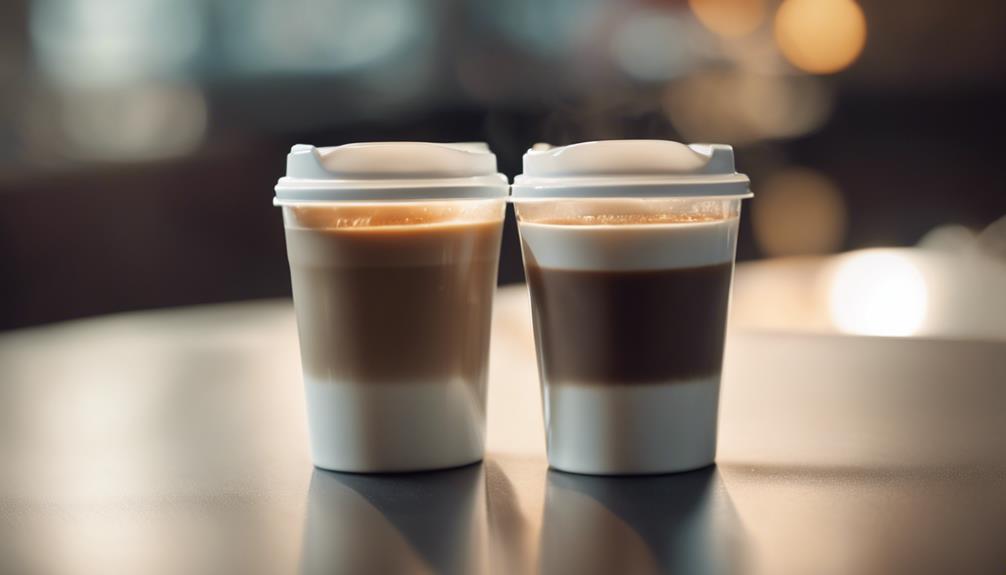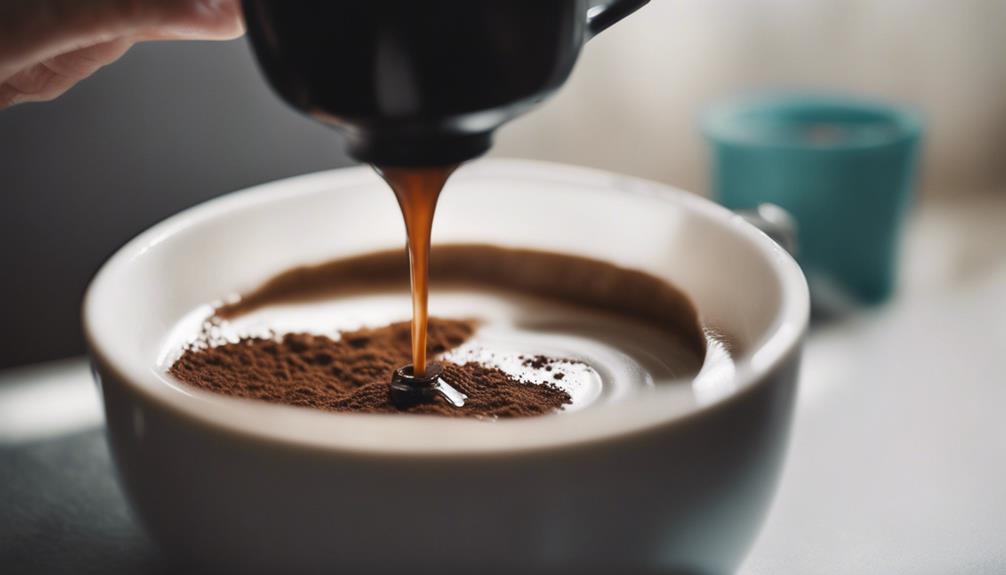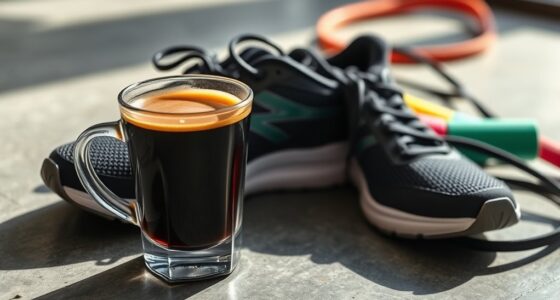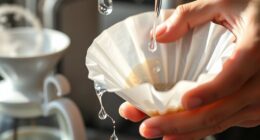When fasting, incorporating creamer into your coffee can have a subtle effect on your glucose and ketone levels, as well as your fat burning process. Cream may impact insulin levels to some extent, but it is unlikely to completely break your fast. There are some concerns about caloric intake and autophagy, but individual success stories demonstrate that adding cream to your coffee can still be a viable option for many people. Knowing these factors will allow you to make educated decisions about including creamer in your fasting routine. Each component contributes to the overall impact of fasting. Delving deeper into these factors can enrich your fasting journey.
Key Takeaways
- Creamer in coffee can slightly impact glucose and ketone levels during fasting.
- Cream may slow down fat burning but doesn't completely halt it.
- Heavy cream has minimal effect on insulin levels while fasting.
- Cream provides accessible calories but could impact autophagy due to caloric intake.
- Many success stories support incorporating cream in coffee for weight loss during fasting.
Impact on Glucose and Ketone Levels
When adding creamer to your coffee while fasting, you may observe a slight decrease in glucose levels and a minor increase in ketones. This effect occurs because the calories from the cream can provide a quick energy source for your body, impacting your glucose levels.
However, it's important to keep in mind that this doesn't necessarily disrupt your body's fat-burning state. Home experiments have shown that while cream may slow down fat burning to some extent, it doesn't completely halt it.
In comparison, black coffee alone is considered more favorable during fasting, as it doesn't introduce any additional calories that could potentially interfere with the fat-burning process. While cream in your coffee may offer a source of calories that your body can readily use before tapping into stored fat, it's essential to take into account the overall impact on your fasting goals.
Effect on Fat Burning Process

Adding cream to your coffee during fasting may moderately slow down the fat burning process, but it doesn't completely halt it. While concerns about how cream impacts the fat burning process exist, research shows that it might not have as significant an effect as once believed.
Here are some key points to keep in mind:
- Studies indicate that cream in coffee doesn't dramatically affect insulin levels during fasting, which is important for maintaining the fasted state.
- Cream, particularly heavy cream, provides easily accessible calories that your body may use before tapping into stored fat for energy.
- Incorporating cream into your fasting routine could potentially make it more sustainable and enjoyable, potentially supporting long-term weight loss efforts.
- The exact impact of cream on processes like autophagy during fasting remains uncertain, with further research needed to understand its effects fully.
Influence on Insulin Levels

Creamer in coffee, particularly heavy cream, has been observed to have minimal impact on insulin levels when consumed during fasting. Studies indicate that adding cream to your coffee may not notably affect insulin levels, making it a viable option for individuals fasting.
While cream in coffee does provide calories that can be used for energy before tapping into stored fat, it's unlikely to completely disrupt the fat-burning process. The slight slowing of fat burning from cream consumption is generally manageable and doesn't break the fast.
In fact, incorporating cream into your coffee during fasting could potentially make the fasting period more sustainable and enjoyable for some individuals without causing notable spikes in insulin. Therefore, if you enjoy creamer in your coffee during fasting, it's likely a suitable choice that complements your fasting routine while allowing you to maintain steady insulin levels.
Concerns About Caloric Intake

Here are some key points to take into account regarding the impact of caloric intake from creamer in coffee on the process of autophagy during fasting:
- Creamer contains calories that can be used by the body before tapping into stored fat reserves during fasting.
- Some worry that even minimal caloric intake, such as from creamer, could potentially disrupt the autophagy process.
- Heavy cream, often used as a creamer, is high in fat and may offer readily available calories during fasting.
- The exact influence of consuming creamer on autophagy during fasting remains uncertain, necessitating further research to clarify its effects.
While some individuals may not experience hindrances in weight loss from incorporating creamer in their fasting routine, concerns persist regarding the impact of caloric intake on the fasting process. It's essential to stay informed about the ongoing research in this area to make well-informed decisions regarding creamer consumption during fasting.
Success Stories and Experiences

In weight loss journeys involving intermittent fasting, many individuals have found success stories and positive experiences when incorporating cream in their coffee. Anecdotal evidence from various individuals, like Keith who lost 80 pounds through intermittent fasting alongside a low-carb and keto diet, suggests that adding cream to coffee can be a beneficial strategy.
For Keith, cream in his coffee not only made the weight loss journey more manageable but also enjoyable. Contrary to some concerns, Keith found that including cream in his coffee during fasting periods didn't impede his progress. This showcases that intermittent fasting paired with cream in coffee can indeed be a successful approach for weight loss.
These personal success stories demonstrate that creamers in coffee need not be a hindrance to achieving weight loss goals, offering a practical and satisfying option for those following similar fasting routines.
Frequently Asked Questions
Can I Have Coffee With Creamer While Intermittent Fasting?
You can enjoy coffee with creamer while intermittent fasting, but be mindful of the calorie content. Creamers exceeding 50 calories may disrupt your fasting state by providing easily accessible calories that can hinder fat burning.
While cream in coffee can slow down fat utilization, it may not completely stop it. Some find adding cream enhances the fasting experience, but be cautious of its impact on calorie intake during fasting periods.
What Can I Put in My Coffee That Won't Break My Fast?
You can enhance your coffee without breaking your fast by using unsweetened almond milk or coconut milk, as they contain minimal calories.
Opt for stevia or monk fruit sweeteners for a touch of sweetness without affecting your fasting state.
Cinnamon or nutmeg can add flavor without compromising your fast.
Be cautious with creamers, as even a small amount can introduce calories that may disrupt your fasting goals.
Can I Have Milk in My Coffee While Intermittent Fasting?
You can have milk in your coffee while intermittent fasting, but be cautious as it can break your fast if it exceeds 50 calories. Dairy milk contains more calories than plant-based alternatives, potentially disrupting your fasting state.
Consuming milk might raise insulin levels, impacting fat-burning during fasting. To stay in the fasted state, opt for black coffee or low-calorie substitutes.
Watch out for additives like cream or sweeteners that can add calories and potentially break your fast.
What Drinks Don't Break a Fast?
When fasting, opt for low-calorie, fat-free drinks like black coffee to minimize disruption to your fasting state. Water, herbal tea, and black coffee are safe choices that won't break your fast.
These options keep your calorie intake low and help maintain fat-burning processes. Avoid sugary or high-calorie beverages as they can spike insulin levels, potentially interfering with fasting benefits.
Stick to non-caloric drinks to support your fasting goals effectively.
Conclusion
Ultimately, incorporating creamer into your coffee while fasting can impact your glucose and ketone levels, disrupt the fat-burning process, and potentially elevate insulin levels. When fasting, it’s best to stick to black coffee to avoid any potential disruptions to your fasted state. If you’re looking for a creamer alternative, consider using the best heavy cream for coffee as a way to add richness without impacting your fasting goals. This will help maintain your glucose and ketone levels and keep your body in a fat-burning state during your fast.
While individual experiences may vary, it's important to take into account the caloric intake of creamer when fasting for specific health goals.
It's vital to be well-informed and make decisions based on accurate information to maximize the benefits of fasting.









